Monstera borsigiana (Monstera deliciosa var. borsigiana) is a Monstera deliciosa variety with smaller leaves, fewer splits and fenestrations, and broader, evenly separated pinnate. It grows as a vining plant, and its geniculum doesn’t have a wavy edge.
Here is everything you need to know about Monstera borsigiana, including Monstera albo borsigiana and the Aurea variegata.
That is not all. We also have care and growth requirements, propagation, prices, where to buy, and a lot more.
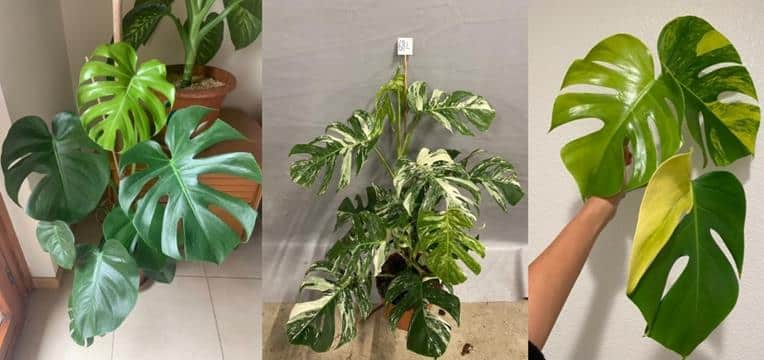
Contents
- Appearance and identification
- 1. Growing habits
- 2. Growth rate
- 3. Juvenile and mature leaves
- 4. Stems
- 5. Flower and fruits
- Variegated Monstera borsigiana
- 1. Monstera albo borsigiana
- 2. Monstera borsigiana Aurea variegata
- Monstera borsigiana care and growth needs
- 1. USDA hardiness zone
- 2. Temperature
- 3. Humidity
- 4. Light
- 5. Soil
- 6. Watering
- a. Overwatered
- b. Underwatered
- 7. Fertilizer
- 8. Pruning and grooming
- 9. Potting and repotting
- How to propagate Monstera borsigiana
- 1. Stem cutting propagation
- a. Soil propagation
- b. Water propagation
- 2. Air layering
- 3. Seeds
- Safety to pets
- Pests
- Diseases and conditions
- 1. Yellow leaves
- 2. Drooping or wilting
- 3. Leaves curling
- 4. Brown leaves, spots, tips, or edges
- Frequently Asked Questions (FAQs)
Appearance and identification
- Scientific name: Monstera deliciosa var. borsigiana
- Genus: Monstera
- Family: Araceae (aroids or arum family)
- Common names: Swiss cheese plant or vine (shared with Monstera adansonii and Monstera obliqua), Split-leaf philodendron, Windowleaf, or fruit salad plant
- Native habitat: Tropical rainforests that range from Panama to Southern Mexico
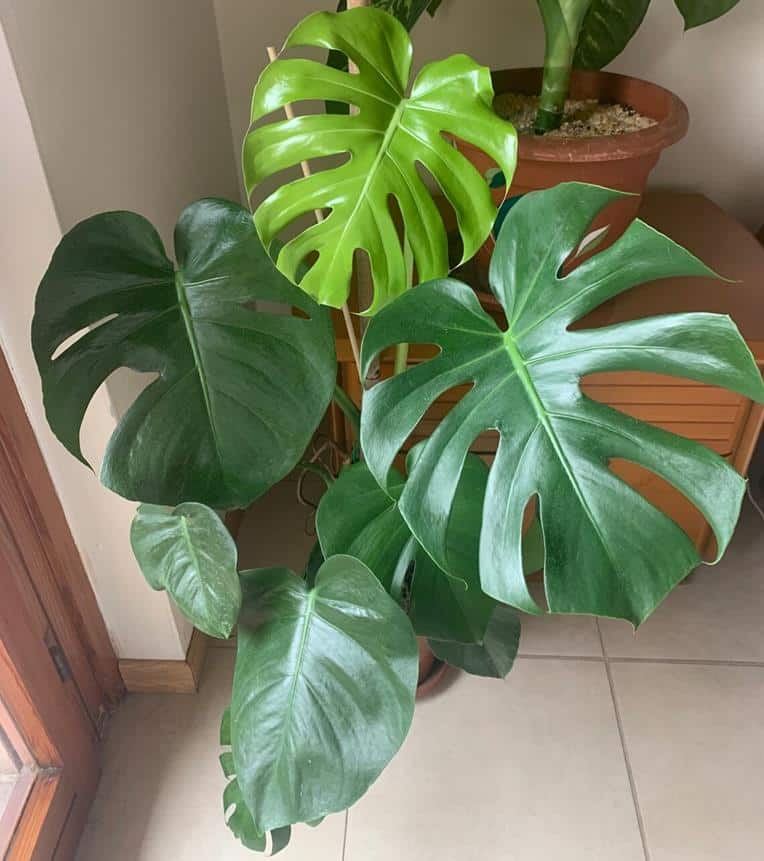
Monstera borsigiana, officially Monstera deliciosa var. borsigiana is one of the varieties of Monstera deliciosa. Most reputed plant databases (1, 2, 3) often refer to it as a heterotic synonym because it is just a variation, not a separate species. The other less popular variety is M. deliciosa var. sierrana, or the common Brazilian form.

Going by the words of the University of Hawaiʻi, College of Tropical Agriculture and Human Resources, borsigiana is a “vining type with smaller, glossy leaves with pinnate lobes widely and evenly separated. The leafstalk is wrinkled where it joins the leaf.”
Another comparison study published at ResearchGate notes that var. borsigiana as “having narrower, high-climbing stems, smooth petioles, smaller leaf blades with much fewer perforations, and slightly smaller flowers.”
Last but not least, since it is just a variety of Monstera deliciosa, it does carry the same names, including ceriman, monster fruit, Swiss cheese plant, Mexican breadfruit, etc.
1. Growing habits
Monstera borsigiana is a hemiepiphyte. This means it grows both as a ground terrestrial plant or an epiphyte. An epiphyte is a plant that grows on others but not parasitically.
This tropical rainforest plant grows on tall tree trunks, receiving filtered light. Unlike the M. deliciosa that may be stout and sprawls or spans over a larger area, borsigiana grows more like a vine plant. But both are climbers and can be as long as 70 feet.
Lastly, in the juvenile stage, it grows as a terrestrial creeper. Once it gets one, it will start growing upwards to reach the light. But the seedling stage shows negative phototropism, i.e., grows towards darkness. Dark areas indicate a place near a large tree trunk.
2. Growth rate
Monstera borsigiana has a medium growth rate. But it grows slightly faster than M. deliciosa.
3. Juvenile and mature leaves
Monstera borsigiana has leathery, glossy deep green heart-shaped leaves with erect leaf stalks longer than the lamina.
In the juvenile stage, leaves are entire, and the petioles are twice as long as the leaf blade or lamina. But they will start splitting at an early age. Thus, some juvenile leaves are splits. But they don’t have a geniculum (knee-like bent) that connects the leaf base to the petiole (leaf stalk).
Mature borsigiana leaves are larger (about 1.6 feet or 18 inches) and more split and fenestrated, i.e., having and holes or perforation (not always). Also, their geniculum is smooth.
By looking at the leaves, you should tell if your plant is a Monstera deliciosa or borsigiana. Monstera borsigiana has smaller leaves (about half the size), the pinnae are broader and evenly separated. Also, their geniculum is smooth, i.e., it doesn’t have any wavy or crispate margin like deliciosa.
See more on Monstera borsigiana vs deliciosa. It will give you all the differences between Monstera deliciosa and borsigiana and much more.
4. Stems
It has green stems with aerial roots for anchoring to a climbing surface. These stems are thinner and have longer internode spaces than Monstera deliciosa.
5. Flower and fruits
Monstera borsigiana flowers only when the plant matures. And for this to happen, it needs a place to climb. It produces tiny white or green inflorescence flowers borne on a spadix. The spadix has white, cream, or yellowish spathe around it.
In the fruiting stage, the spadix will be green or bluish-green and resemble a corn ear with hexagonal scales. This fruit is edible and may have few seeds.
When the hexagonal scale begins to lift, dry, and fall, the fruit ripens and will have an aroma. Ripening occurs from the base upward. Please wait until the whole fruit is ripe, then remove the scales and eat the pulpy that reminiscence banana, pineapple, and mango.
Warning
Eat Monstera deliciosa fruits when they are fully ripe. Or else, it will cause severe oral irritation and a burning feeling because it still has needle-like calcium oxalate crystals when not ripe. Except for ripe fruits, all other parts of this Monstera are toxic or poisonous to humans, pets, cats, and dogs.
Variegated Monstera borsigiana
The most popular variegated form is Monstera albo borsigiana, but others like Aurea Variegata are less common.
1. Monstera albo borsigiana
Monstera albo borsigiana is the most popular variegated form with off-white to white streaks, marbling, or blocks, with some having half-moon, others mainly white.
It occurs due to natural gene mutation, making it unstable, and the variegations may revert. Also, each leaf will be different from another. We have something exclusive on Monstera albo borsigiana. It has care, propagation, where to buy it, prices and a lot more.
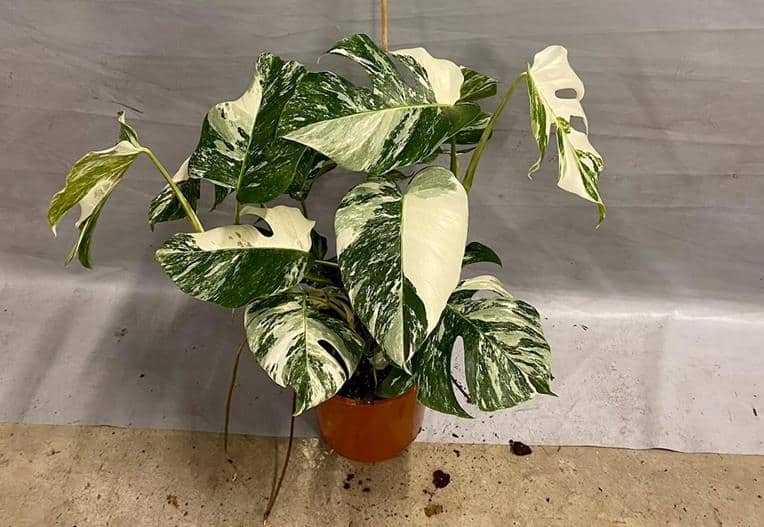
That is not all. Monstera albo borsigiana somewhat resembles Monstera Thai Constellation, but the latter has a cream to whitish speckles, splashes, and streaks that resemble a constellation. It is a tissue culture product from a Thailand lab and has stable variegations.
Last but not least, Monstera albo borsigiana is expensive with a cutting selling at $150 to $300. A rooted and established plant may cost you $300 to $1400.
2. Monstera borsigiana Aurea variegata
Monstera borsigiana Aurea variegata has yellowish variegations, i.e., marbling, streaks, and sectors. Some people will call it Tricolor, Marmorata, or yellow borsigiana, and it may have a mint appearance.
It occurs due to a rare gene mutation, and Monstera borsigiana Aurea variegata is super expensive, selling at between $600 to $2500 at Etsy.com.
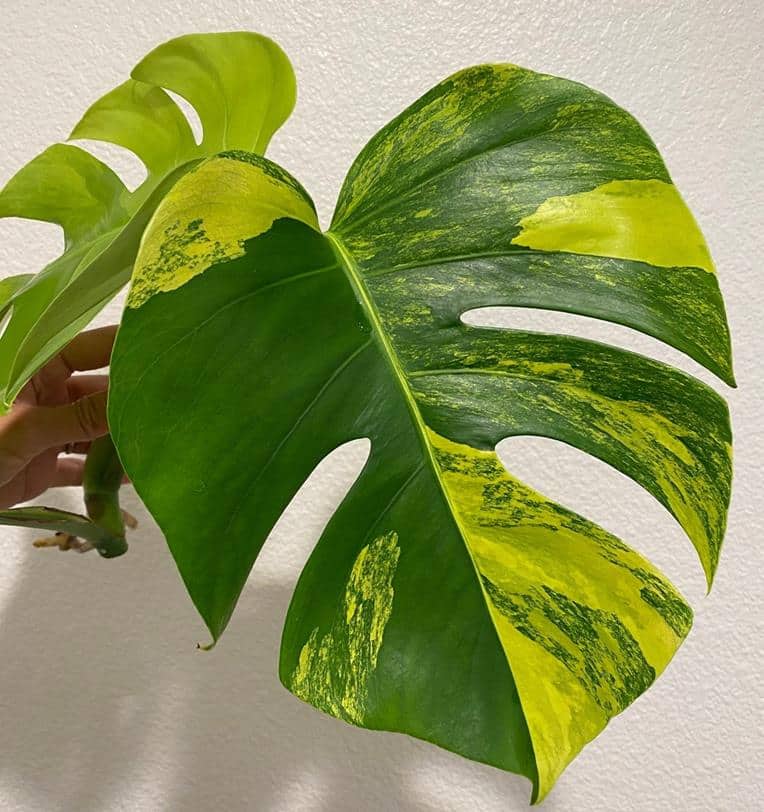
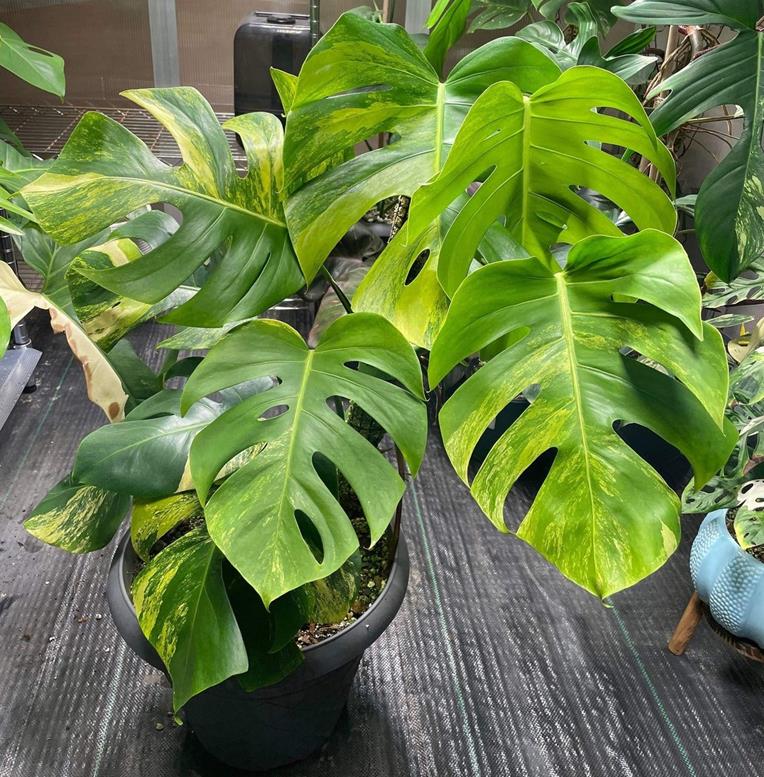
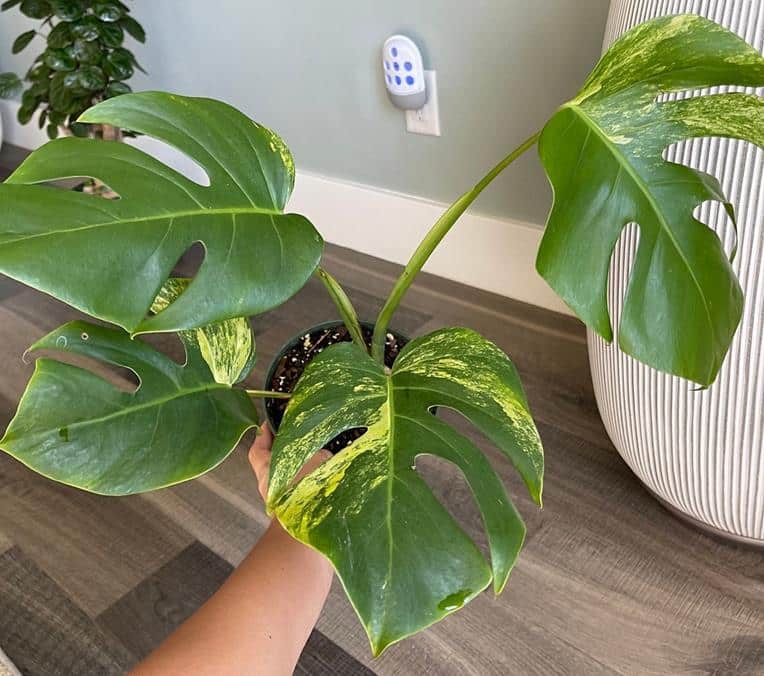
Monstera borsigiana care and growth needs
You know what Monstera borsigiana is and the variegated forms available. It is time to look at care needs. To give you a heads-up, it’s super easy. They can grow under normal household conditions but need slightly higher humidity. Also, you need to know how to water them properly.
Here are care and growth need details:
1. USDA hardiness zone
Monstera borsigiana hardiness zone is 10 to 12. It doesn’t tolerate freezing conditions, and frost will kill it. If you are in these regions, you can grow it outside throughout the year. But ensure you meet other growing requirements.
2. Temperature
The ideal temperature for Monstera borsigiana is 65 to 85 degrees Fahrenheit (18-29°C). Lower temperature will slow growth, and at 50°F (10°C), your plant will cease growing. Also, avoid sudden drops and spikes, cold drafts, or near heat sources (radiators, house heating system vents. etc.).
3. Humidity
These tropical rainforest plants love a humid environment, the optimum being 60% or more, but your Monstera borsigiana can tolerate 50% or more.
Low humidity will cause leaf browning, warns the University of Wisconsin-Madison.
So, if your house humidity is low, mist your plant several times a week, or have a pebble tray. You can also group plants or take them to more humid rooms like the kitchen or bathroom.
However, the best move will be to buy a humidifier. LEVOIT Humidifiers Top Fill, 6 Liter, Cool Mist is our favorite. It comes with a Vesync APP you can connect to Alexa or Google voice assistants. Also, its coverage is extensive and runs for over two days.
4. Light
Monstera borsigiana prefers bright, indirect light. The non-variegated forms can tolerate low to medium. But if you have Monstera albo borsigiana, Aurea variegata, or any variegated form, provide bright, indirect light.
Variegated forms have less chlorophyll. So, they need more light to make enough food and remain healthy. If your house isn’t bright, buy artificial grow lights like GE Grow Light LED Flood Light Bulb.
That is not all. Please don’t place your plant in direct sunlight or near windows, especially the south-facing one. Outdoors, place them under a shade or greenhouse.
Last but not least, if your plant receives light from one side, rotate your plant after every three months for more balanced growth.
5. Soil
Monstera borsigiana needs slightly acidic to neutral (pH 5.5–7) airy or chunky, well-drained soil high in organic matter. You can either buy an aroid mix or make one at home.
A mixture like 30% potting soil, 30% peat moss, 20% perlite, and 20% compost organic matter like worm castings will do the job. You can also add some bark chips and charcoal.
The exact ratios don’t matter so long as your soil drains well, can hold moisture, and is rich in organic matter. These plants are not so fussy.
6. Watering
These plants need moist soil, not soggy or completely dry. Also, it would help if you let the soil slightly dry in-between watering.
Water your Monstera borsigiana when the top 2 to 3 inches of the soil feels dry. This may be about once a week in spring and summer and after 2-3 weeks in winter.
The exact frequency or how often will depend on your conditions (temperature, humidity, or light), pot size or type, plant size, among other factors.
So please, don’t follow a watering schedule. Instead, always feel the soil. Water, when the potting mix is dry up to the first knuckle of your finger or your soil moisture sensor indicates a dry zone. XLUX is an excellent brand.
Last but not least, when watering, slowly and evenly saturate the soil until excess water flows from drainage holes. Wait for about 10 minutes, then discard any that collects on the saucer.
a. Overwatered
Like others, Monstera deliciosa var. borsigiana is sensitive to overwatering, and if not checked, your plant will end up with root rot.
Besides watering too often without testing the soil, other contributing factors are oversized pots, blocked drainage holes, heavy soils, low temperatures, and high humidity coupled with poor air circulation.
Signs include soggy soil even after not watering for a few days, lower yellow leaves, brown splotches on leaves, and wart-like growths (edema). Also, your Monstera may droop or wilt but will not improve with water, have a moldy potting mix, mushy stem base, etc.
See more on underwatered, overwatered, and how often to water Monstera. Also, if you see brown or black mushy roots, this post on Monstera root rot will help.
b. Underwatered
When neglected and thirsty, your Monstera leaves will curl inward, have crispy brown tips and edges, and droop or wilt. Also, it will grow slowly and have yellow leaves. If you don’t water it, leaves will start dropping before it withers and dies.
7. Fertilizer
Plant food will help keep your plant healthy and lush. So as medium feeders, fertilizer your Monstera borsigiana once a month with a balanced, liquid houseplant fertilizer in spring and summer. During non-growing seasons, don’t feed your plants.
I add two pumps of Miracle-Gro Indoor Plant Food (Liquid) to a quart of water and use the solution to feed my plants bi-weekly. It works instantly, is balanced and has never burnt my Monstera.
You can also use a slow-release fertilizer for a houseplant. Start feeding in early spring and follow what the manufacturer says. A good brand I know is Osmocote Smart-Release. Feed once every four months.
8. Pruning and grooming
Pruning will entail cutting off any damaged, diseased, dead, yellow, or brown leaves with a sterilized sharp pruning knife or scissors. And in early spring, you can cut a few branches to shape your plant or encourage fuller growth.
Whenever they are dusty, wipe leaves with a soft microfiber cloth. Why? Dust may affect photosynthesis and make your plant unsightly.
9. Potting and repotting
Repot your Monstera borsigiana after every 2-3 years or when rootbound in spring or summer. If rootbound, you will see roots growing from drainage holes. Also, your plant may be leggy, grow slowly, droop or wilt, have scorched leaves, etc.
How to propagate Monstera borsigiana
The best way to propagate Monstera borsigiana is by stem cuttings in water or soil. But you can also use seeds and air layering.
Seeds will not give you a variegated plant if you have a variegated form like Monstera albo borsigiana. Instead, you should use a cutting and pick a node with a variegated leaf.
We recommend propagating your plant in early spring because it will give your plant more time to grow before the non-growing season.
1. Stem cutting propagation
You are free to use water or soil/medium potting propagation. Both methods are easy. Water allows you to see the roots growing and is less messy. But it takes longer, and plants suffer from more transplant shock.
On the other hand, rooting occurs faster in soil. Your cutting will get more nutrients and experience less transplant shock. But it’s messy, and you cannot see the progress.
a. Soil propagation
Our preferred propagation way is soil. You can use a well-draining potting soil, aroid mix, a mixture of peat moss and perlite, or even sphagnum moss alone.
If sphagnum moss alone, soak it in water and wring excess water. Then, don’t water it after planting your cutting.
Here are the steps to follow:
- Select a healthy, mature stem with at least one node and cut it just below the node with your sterilized pruning shears. If it has more than two leaves, remove the lower ones.
- Apply your rooting hormone on the cut end. It will help promote faster rooting and reduce rot instances. We use Clonex Rooting Gel. Garden Safe Brand and Hormex are also good.
- Make a hole on your potting mix, and plant the cutting, ensuring you cover the node with soil. Lightly tamp the growth media to ensure it stays upright.
- Thoroughly water cutting, and if your home has low humidity, cover it with a transparent polythene bag, leaving a small opening. It will help lock humidity.
- Place the cutting in a warm place with bright, indirect light.
- Routinely, remove the plastic cover for a few hours to let your plant breathe. Also, make sure the soil remains moist. Mist it if it starts drying.
Your plant will root by the end of the 3rd to 5th week. You will also see new leaves unfurling, and you can transplant the cutting when roots are long enough.
b. Water propagation
Instead of planting the cutting in soil, you will put it in a jar with water. Ensure the node is covered and not leaves.
Then, place your plant in a warm place with direct light and change the water after 3 to 4 days or when the level drops.
By the end of the 4th or 6th week, the roots may have grown long enough and are ready for transplant. But how soon it happens depends on the conditions you provide. You will also see new growth.
2. Air layering
Select a node on a healthy stem or branch you want to use in your propagation, apply a rooting hormone, and make a small nick near the node. Then, take a moist sphagnum moss ball wrap it on the node with a plastic bag.
Poke small holes with a toothpick for aeration and mist the sphagnum moss. After 3 to 4 weeks, your node will have rooted. When roots are large enough, cut the stem below the node and transplant it.
3. Seeds
You can propagate Monstera borsigiana is by seeds if you are lucky to find them. What is readily available at Etsy.com is Monstera deliciosa seeds.
Once you have the seeds, soak them for half a day in lukewarm water (optional). Then put a well-draining potting mix in your germination tray, make small holes about ½ an inch, place your seeds, and cover them.
Next, place the seeds in your germination chamber or a warm place (70 -75°f (21 to 24 °C) and ensure the soil remains moist. They will germinate after about two weeks and will take up to 12 weeks for the seedlings to be ready for repotting to individual pots.
Warning
Monstera seeds lose viability quickly if allowed to dry. Buy your seeds from a trusted vendor and store them in a moist place.
Safety to pets
Like others, Monstera borsigiana is toxic or harmful to humans, dogs, cats, and other pets. Why? Because it has sharp or needle-like insoluble calcium oxalates. When chewed, they will cause severe burning sensation and mouth irritation. Also, your mouth, tongue, or lips may swell and turn red.
More signs are drooling, lack of appetite, and mouth-pawing in pets. Please, keep it out of pets’ and children’s reach.
Pests
Pests are not common in this plant when grown indoors. But it may end up with whiteflies, spider mites, thrips, scale insects, and mealybugs. You will see tiny bumps or dots that may be stationary, move or leap, some with wings or fluffy bodies.
Signs are specific to bugs your plant has. They include webbing, silvery stippling, honeydew, sooty mold, black or brown spots, etc. If heavily infested, leaves may get ruffled, mishappen, turn yellow, fall, and your plant will grow slowly.
To control pests, hose these pests off your plant, use insecticidal soap like Garden Safe Brand Insecticidal Soap Insect Killer, neem oil, or horticultural spray oils to manage them. Also, isolate infested and new plants.
Diseases and conditions
Diseases typical to this Monstera include southern blight, botrytis, anthracnose, bacterial leaf spot, and Monstera mosaic virus. But they are rare. The most probable issue is root rot that is mainly due to overwatering. See more on Monstera root rot for symptoms, treatments, or how to fix it.
1. Yellow leaves
Overwatering is the most often cause. However, it may occur due to low or too much light, heat stress, nutritional deficiency, overfeeding, pests, diseases, old age, among other causes.
2. Drooping or wilting
Your Monstera leaves wilting or drooping means they don’t have enough water. Underwatering is the leading cause. But anything that will promote faster water loss from leaves or roots to absorb water may be a cause. Here you will get low humidity, heat stress, diseases, pests, overfeeding, overwatering, etc.
3. Leaves curling
Leaves curl to reduce moisture loss or protect the plant. The leading cause is underwatering. Others are too much light, extreme temperatures, low humidity, pests, or your plant may be root bound.
4. Brown leaves, spots, tips, or edges
Crispy brown edges and tips occur due to underwatering, too much light, heat stress, transplant shock after repotting, or too much fertilizer. Diseases and pests will cause brown spots, and overwatering will black or brown splotches. If leaves turn brown overnight, they may be cold drafts.
Frequently Asked Questions (FAQs)
Not at all. Monstera deliciosa var. borsigiana is not rare. It is readily available in big box stores like Walmart and Home Depot sell it as the Swiss-cheese plant. But variegated forms, especially Monstera albo borsigiana, are rare and pricey.
Non-variegated Monstera borsigiana goes for between $10 to $25. And Compared to Monstera deliciosa, this variety is a little cheaper. But what you pay will depend on where you buy it and your plant size. Fully grown or larger plants will cost more.
On the other Variegated forms like Monstera albo borsigiana is very expensive, with cuttings going for $150 to $300 and established plants for up to $1500.





Leave a Reply